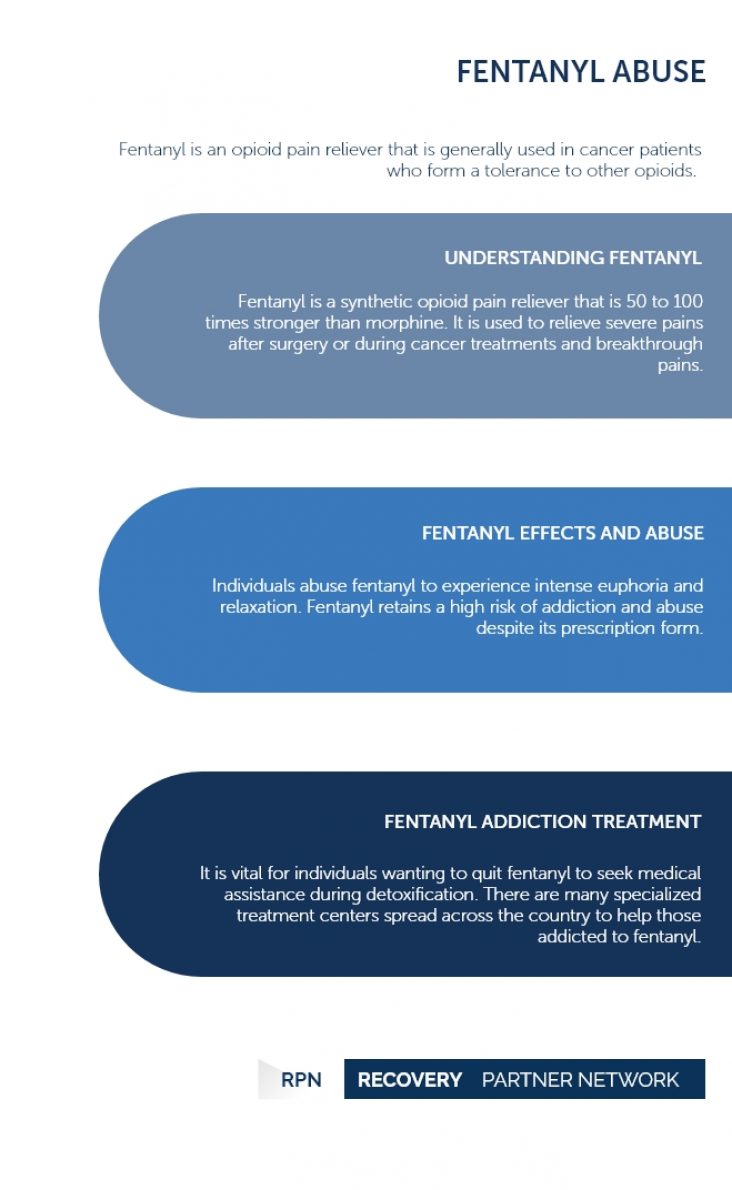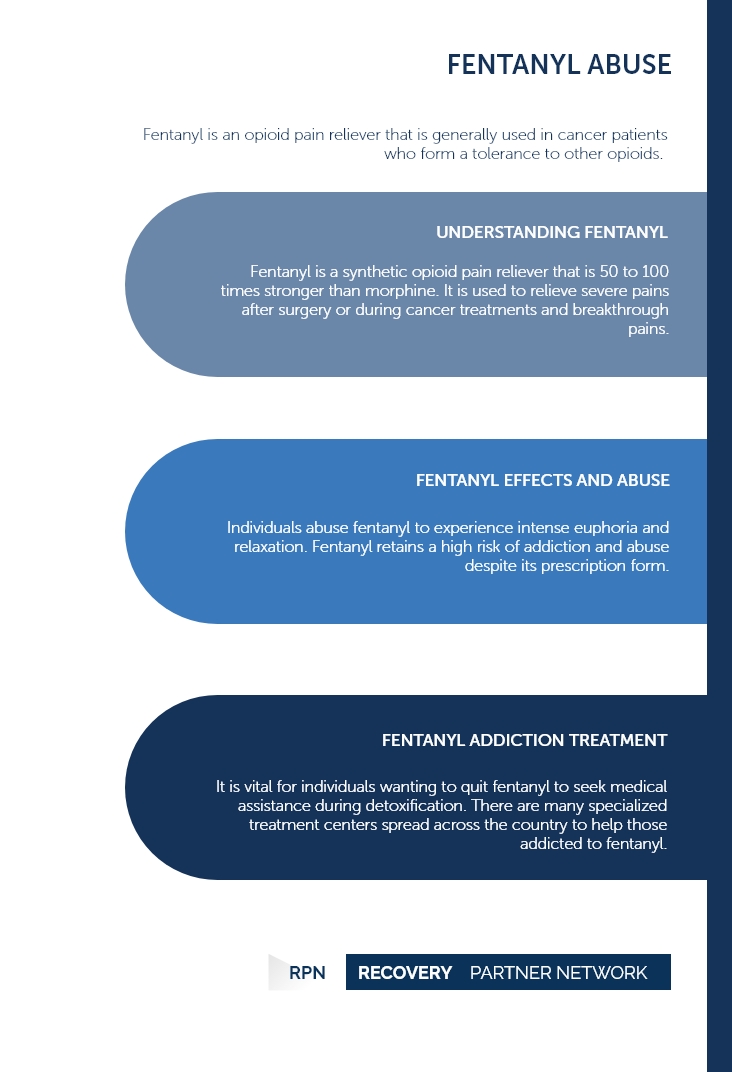Fentanyl is an opioid pain reliever that is generally used in cancer patients who form a tolerance to other opioids.
Fentanyl Abuse
Opioid
- Hydrocodone/paracetamol addiction
- Buprenorphine/Naloxone addiction
- Central nervous system depressant
- Codeine addiction
- Dextropropoxyphene addiction
- Fentanyl abuse
- Hydromorphone addiction
- How Long do Opioids Stay in Your System?
- Hydrocodone addiction
- Kava addiction and abuse
- Loperamide addiction
- Lortab addiction
- Medical prescription opioid
- Methadone addiction
- Morphine addiction
- Norco addiction
- NyQuil addiction
- Opioid use disorder
- OTC substance abuse
- Oxycodone addiction
- Oxycodone/paracetamol addiction
- Opioid epidemic
- Lean addiction
- Pethidine addiction
- Snorting Oxycodone
- Synthetic Opioids
- Tramadol addiction
Fentanyl abuse | Table of Contents
Understanding Fentanyl
Fentanyl is a synthetic opioid pain reliever (OPR) that is 50 to 100 times stronger than morphine. Fentanyl is typically used to relieve severe pains after surgery or during cancer treatments and breakthrough pains (flare-ups of intense pain that occur despite round-the-clock narcotic treatment.) It works by blocking the pain receptors in the brain and enhancing the production of dopamine.
Some of the street names of fentanyl are:
- China girl
- Dance fever
- Apache
- Crush
- TNT
Fentanyl is available in many forms and brands such as:
This form of fentanyl is available as a lozenge on a plastic stick to be administered under the tongue like a lollipop. It has some military applications but is generally used to manage breakthrough pains in patients already on pain-relieving medications.
This fentanyl patch was first introduced in the 1990s to treat moderate to severe pain. The effects of this patch generally last for three days.
This is the injectable form of fentanyl that is generally administered in hospitals, sometimes along with anesthetics, to manage pain before and after surgery.
This is a sublingual spray that is typically administered under the tongue to provide immediate pain relief. Subsys is primarily used to treat breakthrough cancer pains.
This is the quick-dissolve version of fentanyl that is typically placed under the tongue to provide immediate relief for opioid-tolerant patients with breakthrough cancer pains.
This is a fentanyl nasal spray that is administered just like a common nasal decongestant spray to treat pain in cancer patients.
FAQ
- How addictive is fentanyl?
- What are the street names for fentanyl?
- What are the health risks of fentanyl use?
- What is the risk of fentanyl overdose?
Fentanyl, which falls under the category of synthetic opioids, is extremely addictive and at least fifty to a hundred times stronger than morphine.
Some of the street names of fentanyl may include China Girl, China White, Apache, Friend, Dance fever, Goodfella, TNT, Tango and Cash, Murder 8, Jackpot, Drop dead, and Percopop.
Continued consumption of fentanyl can cause significant complications that affect all areas of an individual’s life. It could lead to slow respiration, damage to the lungs, heart, and other organs. Sharing needles during drug use could also lead to the transmission of infectious diseases. Misuse of fentanyl could lead to anxiety disorders and depression and trigger the symptoms of underlying mental illnesses.
Fatal overdoses due to fentanyl typically result from respiratory collapse, but other harmful or fatal adverse effects, including brain injury that is attributable to oxygen depletion, heart attack, or organ failure, can be caused by the drug’s tendency to depress central nervous system function.
Fentanyl Effects and Abuse
Similar to most other potent OPRs, fentanyl retains a high risk of addiction and abuse despite its prescription form. The National Institute on Drug Abuse (NIDA) has sternly warned that a fentanyl epidemic is highly possible due to the substance’s addictive potential.
Fentanyl can turn into a potentially lethal drug when abused recreationally or taken as opposed to prescription. Individuals consuming unprescribed quantities of fentanyl may undergo intense euphoria and a sense of relaxation that is quite similar to heroin.
The other symptoms of fentanyl abuse are:
- Seizures
- Headaches
- Dizziness
- Nausea and vomiting
- Itching
- Constipation
- Blurred vision
- Mellowness
- Drowsiness
- Slowed breathing
Fentanyl abuse can also depress the respiratory system to the extent of its failure, resulting in a fatal overdose. Individuals without tolerance to opioids are particularly vulnerable to the risks of a fentanyl overdose, as the substance’s already elevated risks of overdose is increased by multiple folds when someone without a tolerance abuses it. In addition, combining fentanyl with illicit narcotics such as cocaine may also exacerbate the drug’s harmful side effects.
Signs of a Fentanyl Addiction
Fentanyl imposes a significant influence on the central nervous system, triggering an excess of dopamine to flood and chemically modify the brain over time. These neurological changes may cause a patient who was prescribed fentanyl to form a dependence on the drug and turn to illegal means of obtaining it after the prescription runs out. Once the user forms a tolerance and dependence on fentanyl, he/she may start to rely on it to function normally and gradually require increasing amounts of it to attain the desired effects. Abuse of OPRs such as fentanyl can quickly pave the way for addiction.
Healthcare professionals now make use of the Diagnostic and Statistical Manual of Mental Disorders’ (DSM) criteria for diagnosing substance use disorders to detect problematic behaviors such as developing a tolerance or experiencing withdrawal symptoms.
FAQ
- What are the signs of fentanyl addiction?
- What are the side effects of fentanyl?
- What are the dangers of mixing fentanyl with other drugs?
Failing to cut down on fentanyl despite the desire to stop, experiencing cravings and withdrawals, neglecting obligations and responsibilities in favor of fentanyl use, and continued use of the drug despite the damaging physical and psychological effects are a few of the signs of fentanyl addiction.
Some of the side effects of fentanyl use are constipation, nausea, vomiting, abdominal cramps, sweating, insomnia, fatigue, drowsiness, feeling cold, headache, mood swings, changes in appetite, depression, anxiety, confusion, hallucinations, muscle spasms, tremors, and slowed heart reaction.
Combining fentanyl with any other CNS depressants, especially narcotics, is highly dangerous. CNS depressants such as alcohol, benzodiazepines, opioids, and marijuana amplify the effects of other drugs, placing the person at a higher risk of an overdose. Mixing the drug with opioids particularly raises the risk of respiratory depression, which limits the amount of oxygen reaching the brain; the person can also stop breathing altogether and eventually die.
Fentanyl Addiction Treatment
Quitting fentanyl cold-turkey can be quite distressing but is rarely life-threatening. Individuals with an addiction to fentanyl will undergo painful withdrawal symptoms when they stop taking the drug or reduce drug use abruptly. These withdrawal symptoms vary in severity based on a number of factors, such as the level of use and the form of the substance.
Withdrawal symptoms may include:
- Irritability
- Chills
- Sweating
- Restlessness
Despite the non-lethal nature of fentanyl withdrawal, users are still vulnerable to relapses during this period. Thus, it is vital for individuals wanting to quit fentanyl to detox under the supervision of a medical professional. There are many specialized treatment centers spread across the country to help those addicted to fentanyl.
FAQ
- What is fentanyl withdrawal like?
- What treatment options work best to treat fentanyl addiction?
- Are there support groups for Fentanyl addiction?
- What relapse prevention techniques exist for fentanyl?
Fentanyl withdrawal can be particularly distressing due to its severity. Fentanyl withdrawal symptoms include chills, joint or muscle pain, stomach cramps, nausea, vomiting, diarrhea, anxiety, insomnia, hypertension, muscle weakness, and rapid heart rate.
Given the severity and risks associated with opioid dependence, certain medications have been developed to treat drug-related addiction disorders such as fentanyl directly. These medication-assisted treatments work best in conjunction with standard addiction rehabilitation programs, support group involvement, therapy, and ongoing aftercare.
There are a number of support groups across the United States that help people struggling with narcotics addiction to remain sober and healthy. The most well-known self-help groups are those affiliated with Alcoholics Anonymous (AA), Narcotics Anonymous (NA), and Cocaine Anonymous (CA), all of which are based on the 12-step model. Support groups for family members of people with addictions, like Al-anon or Alateen, can also be helpful.
The most common relapse prevention techniques used for all types of addictions are a healthier diet, exercise, and a support network that comprises of ongoing therapy and support group attendance. However, people struggling with narcotics addiction, especially to potent drugs such as fentanyl, may require the assistance of medications to overcome withdrawal symptoms and prevent relapses.
Recovery Partner Network
We aim to educate and empower. If you feel our library of resources does not cover your specific need, reach out to us, and we would be happy to help.
STATISTICS
© Copyright 2024


